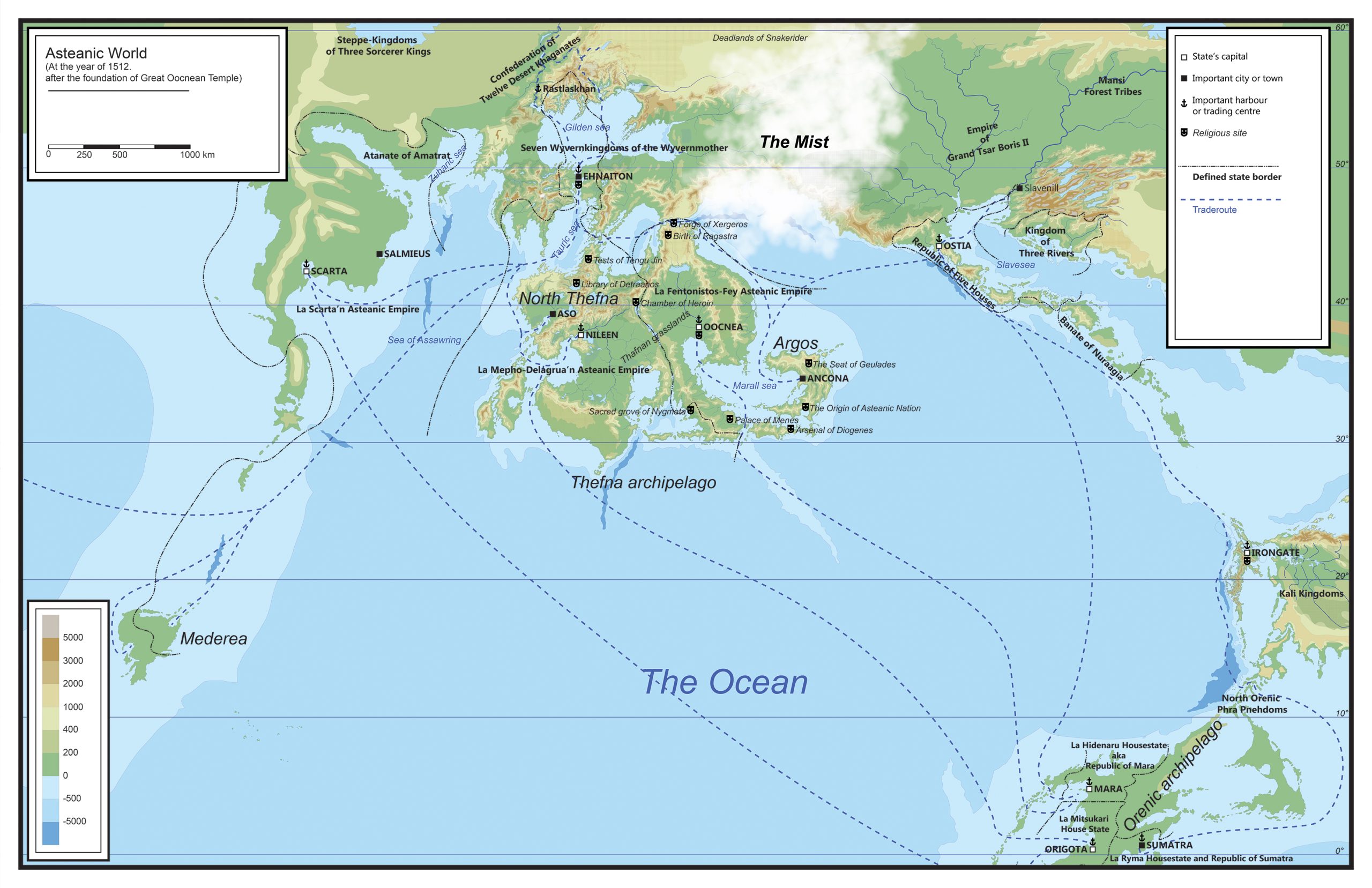With last year’s Dungeon23 │ City23 still unfinished (don’t worry, it will be finished) I thought that it would be a great idea to take part in Lore24. I won’t be posting every day or even every week, but from time to time, as I will be working naturally with the lore of Asteanic World – a thing I have to do anyway, as the lore chapter still needs to be translated for the Full SAKE Rulebook.
And what’s a better place to start with the lore of the Asteanic World than its history. So here is the first part translated just now:
The Short History of the Asteanic World
Asteanic chronology divides the world’s history into four eras: the Mythic Age when Thefna (the Asteanic motherland) was home to the lost Azzurian civilization, the Age of Heroes when gods walked the earth and ancient heroes cleansed the world of all kinds of monsters, making it habitable, the Age of Kings when the first Asteanic kingdoms rose, marking the beginning of credible written sources, and the Age of Empires or the New Age, that marks the start of the Asteanic calendar.
Mythic Age
Little has survived from the Mythic Age, likely ending approximately 3000 to 4000 years ago. During this time, Thefna was home to the Azzurians, a completely extinct or assimilated people among the Asteans. The remnants of this era on Thefna include several ruined cities with massive necropolises and ziggurats. The largest among them are Urtari, Hatussa, and Mitanni, located away from the main civilization. Cities closer to civilization have largely been dismantled by the Asteans for their construction projects.
From the Azzurians, Asteans inherited something of immense significance: their gods. Asteans consider the Azzurian gods as deities of natural forces and continue to revere (mainly fear) them to this day. Azzurians identified themselves as the children of the sun god Azzur and worshipped and feared their gods fervently.
While some aspects of Azzurian writing have been deciphered, the absence of significant texts raises more questions than answers about their culture. Historians debate whether the Azzurians were aware of the Astral Projection magic school. What led to the demise of their culture and paved the way for the Asteans? Some signs suggest that the Azzurians harboured immense fear of otherworldly forces and death. Why, what was so different in that time?

Age of Heroes
The Age of Heroes marks the beginning of Asteanic mythology. The era commences with the tale of how the Asteans descended from the Eternal Waters (pocket of the Otherworld) to the human world. All stories of the deeds of Asteanic gods fall into this era.
The Age of Heroes also encompasses tales of various human heroes and the slaying of monsters and dangerous lesser gods.
There are no written sources from the Age of Heroes because the Asteans had not yet developed writing. All stories have been preserved as oral traditions and are therefore more myths than subjects for serious historical inquiry.
It is unclear whether the Azzurians lived alongside the Asteans during this time. Oral tradition is contradictory in this regard. In some tales, Asteanic heroes battle seemingly foreign nations, but these may also be kinfolk of the Asteans (Asteanic language only becomes standardized in the Age of Empires) or the Hattu peoples who lived in Northern Thefna. In other stories, the Asteans find Thefna seemingly empty, abandoned by its ancient inhabitants.
In some ways, the Age of Heroes has the most stories, being the core of Asteanic mythology, but it has the least credible historical information. Modern Asteans view these stories as what they are – myths. Certainly, some tales may contain a grain of truth.
Age of Kings
The Age of Kings is considered to span seven to eight centuries before the Age of Empires. During this period, writing emerges, providing ample opportunities for a more detailed study of this era. However, there are challenges in precisely dating events because it is nearly impossible to reconcile the different calendars used at that time with the contemporary one.
At different times, dozens of small kingdoms coexisted in Thefna.
This era also marks the first attempt at empire building when Pyrdema, the sorceress queen of Niobe, compelled all the Southern Thefna kings to swear allegiance to her over her long life. Pyrdema’s grand empire lasted for several decades until her own grandchildren rebelled against her and dethroned her.



























Leave a Reply